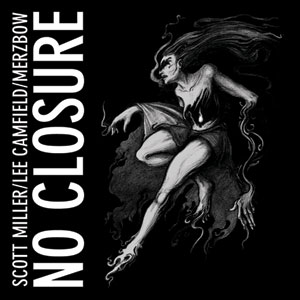Scott Miller/Lee Camfield/Merzbow, "No Closure"
 I will admit that I have always been a bigger fan of Masami Akita's collaborative efforts than the unscalable mountain that is his solo material. As the de facto figurehead in the Japanoise scene (and arguably, noise as a genre, including the artistic controversy, irreverence, and the platitudes of misanthropy so seemingly representative of the scene), Merzbow has, for me, always remained a reliable proof-of-concept but not something I would consistently find myself listening to. However, there has always been interesting results to come from his working with just about anyone who would dare test his aesthetics, and this latest product is no exception. Scott Miller and Lee Camfield (ex-Sutekh Hexen) provide a backdrop of (relatively) human instrumentation and occasional sense, which is then deliciously cannibalized by Akita's digital processing.
I will admit that I have always been a bigger fan of Masami Akita's collaborative efforts than the unscalable mountain that is his solo material. As the de facto figurehead in the Japanoise scene (and arguably, noise as a genre, including the artistic controversy, irreverence, and the platitudes of misanthropy so seemingly representative of the scene), Merzbow has, for me, always remained a reliable proof-of-concept but not something I would consistently find myself listening to. However, there has always been interesting results to come from his working with just about anyone who would dare test his aesthetics, and this latest product is no exception. Scott Miller and Lee Camfield (ex-Sutekh Hexen) provide a backdrop of (relatively) human instrumentation and occasional sense, which is then deliciously cannibalized by Akita's digital processing.
The first half of No Closure begins about as uncapriciously as anything that Merzbow has ever laid hands on. A stagnant cycle of guitar pedal drone and bassy thunder—part one of the equation throughout surely reads: "Miller and Camfield make something organic and safe"—ebbs menacingly, an austere and solemn growl. Vaguely baroque and antique, these first initial dissonances are quickly attacked by a clattering of noise; clicking, screeching, glass endlessly shattering, windows shuttering and fires burning. This is part two: "Masami tears everything apart." There is no doubt he is quite good at doing so, but it always makes for a nice and interesting experience to really engage with one or two of his pieces wholly, as taken separate from the absurd depths another solo release will be unceremoniously thrown into.
The second half of the record, "II," finds Merzbow's electronic buzzing in something of a role reversal. Now that I am accustomed to the palette of caustic hiss and scraping, the most surprising elements of change come from Scott and Lee's end. Confronted with the sociopathic totality of pure noise, they backpedal into black metal theatrics, pounding away at a low-end motif of guitar distortion—a distant behemoth, answering Merzbow's skittering insect inquisitiveness with encroaching assured annihilation. The performers play off one another spectacularly in the middle sections of "I" and "II" where the anticipation and the impatience reach their first peak, where everything congeals into pure, vindictive chaos.
Merzbow breathes absurd fluctuating sonic textures into everything he touches and that is an assumed feature of working with him. What makes his collaborative efforts so great is the spatial discomfort he can cause with a lifetime of apt sound sculpting, and the way it affects sounds and forms that had hitherto existed in their own private space. Given a malleable source, he thrives on imbalance and anxiety, proffering a substitute to tension with his brand of real, finite anguish. The intrigue of this collaboration is the imagined or inferred threat, and the real, provoked injury, held in consideration simultaneously. In other words, the promise and the payoff are happening at once. Miller and Camfield are more than adept at navigating this new weird duality, and serve as one of the better non-melodic foils to Akita in recent memory.
Samples:



